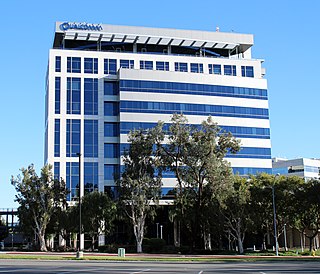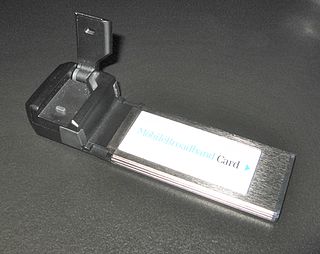
Qualcomm Incorporated is an American multinational corporation headquartered in San Diego, California, and incorporated in Delaware. It creates semiconductors, software, and services related to wireless technology. It owns patents critical to the 5G, 4G, CDMA2000, TD-SCDMA and WCDMA mobile communications standards.

3G is the third generation of wireless mobile telecommunications technology. It is the upgrade to 2G, 2.5G, GPRS and 2.75G Enhanced Data Rates for GSM Evolution networks, offering faster data transfer, and better voice quality. This network was superseded by 4G, and later by 5G. This network is based on a set of standards used for mobile devices and mobile telecommunications services and networks that comply with the International Mobile Telecommunications-2000 (IMT-2000) specifications set by the International Telecommunication Union. 3G is used in wireless voice telephony, mobile Internet access, fixed wireless Internet access, video calls and mobile TV.
Verizon is an American wireless network operator that previously operated as a separate division of Verizon Communications under the name Verizon Wireless. In a 2019 reorganization, Verizon moved the wireless products and services into the divisions Verizon Consumer and Verizon Business, and stopped using the Verizon Wireless name. Verizon has 114.8 million subscribers as of March 31, 2024. It currently has the largest network in the United States with their LTE network covering 70% of the United States.

Infineon Technologies AG is Germany's largest semiconductor manufacturer. The company was spun-off from Siemens AG in 1999. Infineon has about 58,600 employees in 2023 and is one of the ten largest semiconductor manufacturers worldwide. In 2023 the company achieved sales of €16.309 billion.

The history of mobile phones covers mobile communication devices that connect wirelessly to the public switched telephone network.

Mobile broadband is the marketing term for wireless Internet access via mobile (cell) networks. Access to the network can be made through a portable modem, wireless modem, or a tablet/smartphone or other mobile device. The first wireless Internet access became available in 1991 as part of the second generation (2G) of mobile phone technology. Higher speeds became available in 2001 and 2006 as part of the third (3G) and fourth (4G) generations. In 2011, 90% of the world's population lived in areas with 2G coverage, while 45% lived in areas with 2G and 3G coverage. Mobile broadband uses the spectrum of 225 MHz to 3700 MHz.

MediaTek Inc., sometimes informally abbreviated as MTK, is a Taiwanese fabless semiconductor company that designs and manufactures a range of semiconductor products, providing chips for wireless communications, high-definition television, handheld mobile devices like smartphones and tablet computers, navigation systems, consumer multimedia products and digital subscriber line services as well as optical disc drives.
UNISOC, formerly Spreadtrum Communications, Inc., is a Chinese fabless semiconductor company headquartered in Shanghai which produces chipsets for mobile phones. UNISOC develops its business in two major fields - consumer electronics and industrial electronics. This includes smartphones, feature phones, smart audio systems, smart wear and other application fields. Industrial electronics cover the fields such as LAN IoT, WAN IoT and smart display.

Snapdragon is a suite of system-on-a-chip (SoC) semiconductor products for mobile devices designed and marketed by Qualcomm Technologies Inc. The Snapdragon's central processing unit (CPU) uses the ARM architecture. As such, Qualcomm often refers to the Snapdragon as a "mobile platform". Snapdragon semiconductors are embedded in devices of various systems, including vehicles, Android, Windows Phone and netbooks. In addition to the processors, the Snapdragon line includes modems, Wi-Fi chips and mobile charging products.
In telecommunications, long-term evolution (LTE) is a standard for wireless broadband communication for mobile devices and data terminals, based on the GSM/EDGE and UMTS/HSPA standards. It improves on those standards' capacity and speed by using a different radio interface and core network improvements. LTE is the upgrade path for carriers with both GSM/UMTS networks and CDMA2000 networks. Because LTE frequencies and bands differ from country to country, only multi-band phones can use LTE in all countries where it is supported.

MiFi is a brand name to describe a wireless router that acts as a mobile Wi-Fi hotspot device.

Mobile technology is the technology used for cellular communication. Mobile technology has evolved rapidly over the past few years. Since the start of this millennium, a standard mobile device has gone from being no more than a simple two-way pager to being a mobile phone, GPS navigation device, an embedded web browser and instant messaging client, and a handheld gaming console. Many experts believe that the future of computer technology rests in mobile computing with wireless networking. Mobile computing by way of tablet computers is becoming more popular. Tablets are available on the 3G and 4G networks.

Icera Inc. is a British multinational fabless semiconductor company headquartered in Bristol, United Kingdom, and a wholly owned subsidiary of Nvidia Corporation. It has developed soft modem chipsets for the mobile devices market, including mobile broadband datacards, USB sticks, and embedded modems for smartphones, laptops, netbooks, tablets, e-books and other mobile broadband devices.

A mobile broadband modem, also known as wireless modem or cellular modem, is a type of modem that allows a personal computer or a router to receive wireless Internet access via a mobile broadband connection instead of using telephone or cable television lines. A mobile Internet user can connect using a wireless modem to a wireless Internet Service Provider (ISP) to get Internet access.

A baseband processor is a device in a network interface controller that manages all the radio functions ; however, this term is generally not used in reference to Wi-Fi and Bluetooth radios. A baseband processor typically uses its own RAM and firmware. Baseband processors are typically fabricated using CMOS or RF CMOS technology, and are widely used in radio-frequency (RF) and wireless communications.

ip.access Limited is a multinational corporation that designs, manufactures, and markets small cells technologies and infrastructure equipment for GSM, GPRS, EDGE, 3G, 4G and 5G. The company was acquired by Mavenir in September 2020.
3G mobile telephony was relatively slow to be adopted globally. In some instances, 3G networks do not use the same radio frequencies as 2G so mobile operators must build entirely new networks and license entirely new frequencies, especially so to achieve high data transmission rates. Other delays were due to the expenses of upgrading transmission hardware, especially for UMTS, whose deployment required the replacement of most broadcast towers. Due to these issues and difficulties with deployment, many carriers delayed acquisition of these updated capabilities.
The Intel XMM modems are a series of 4G LTE, LTE Advanced, LTE Advanced Pro and 5G modems found in many phones, tablets, laptops and wearables developed by Intel Mobile Communications. Intel Mobile Communications was formed after Intel acquired the Wireless Solutions (WLS) division of Infineon early in 2011 for US$1.4 billion.












